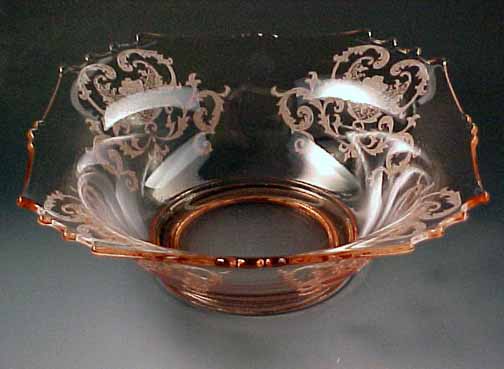National Depression Glass Association
Preserving America's Glass Manufacturing Heritage
Art Deco Styled Glass
by Kathy Eickholt
Art Deco styling in the 1920s and 30s brought glamour and design
excitement by combining curves and angles, lines and circles. It
was cubism brought to the real world with interesting geometric
combinations and was a striking change from the free-flowing
 naturalistic Art Nouveau movement that preceded it. Many of our
most desirable glass patterns from the depression era have deco
style, including Fostoria's Mayfair, Hazel Atlas' Moderntone,
Heisey's Twist, and even simple depression patterns like Block
Optic, Miss America and Jeannette's Doric.
naturalistic Art Nouveau movement that preceded it. Many of our
most desirable glass patterns from the depression era have deco
style, including Fostoria's Mayfair, Hazel Atlas' Moderntone,
Heisey's Twist, and even simple depression patterns like Block
Optic, Miss America and Jeannette's Doric.
The basic elements of Art Deco are strong geometrics. You see the shape and the shape itself has a presence. Some glass patterns have the shape alone while others add decorations to piece shapes that were pleasing by themselves. Consider the very attractive Fostoria Mayfair. Square shapes abound in Mayfair; plates are square, goblets have square feet. George Sakier designed this pattern and it is in person quite lively. For example, the saucers slope upwards in a slight curve and the corners have three little nubs. Now add graceful etchings and you have a winner! We have the Mayfair relish with the curvy Rambler etching on the square-feeling 16-sided glass tray that just looks beautiful.
Moderntone is a depression pattern by Hazel Atlas that came in cobalt blue and some amethyst and clear. Look at the Moderntone salt and pepper shaker bases shown. The stair step design is one common theme you will see in deco-styled glass. If you have seen any movies or photos showing 1930s skyscrapers you'll see the resemblance in this simple kitchen glass object.
Heisey must have had fun with their Twist pattern - the handles on cups are zig zag like lightening bolts - and the pieces are essentially round with an exaggerated wide twist optic. Paden City and other glass companies made patterns with wide twist optics but Heisey's is distinctive.
Hocking's Block Optic is a simple pattern with vertical fluting on one side and a horizontal optic on the interior, with the combination looking like squares. This mass-produced depression pattern shows some of the deco love of circles and squares. Hazel Atlas' Modernistic or Colonial Block is similar to Block optic with an even stronger sense of period style.
Several of Hocking's depression glass tumblers are obviously shaped to fit the predominate trend. Princess and Mayfair cone shaped tumblers with round feet and the Miss America round stems with square feet are perfect examples combining curves and angles.
The bowl in the photo is part of a console set that is similar to Fostoria's Mayfair with square shapes, cut off corners and little nubs. This is enlivened by the beautiful etching. The original owner would have displayed this bowl flanked with its two matching candle holders on a narrow entry way table or against the wall. Imagine this in a 1920s room with the stepped molding, curves and little extra design touches!
Art Deco was named after an exhibition in Paris called Exposition Internationale des Arts Decoratifs et Industriels Modernes held in 1925. The style lasted through much of the 1930s and was revived in part during the 1960s. If you consider the Mid-Century Modern designs of the 1950s, those also used strong shapes, but were usually more curved, streamlined and pared down. Art Deco didn't use the embellishments so common in earlier periods but was a far cry from the spare designs of the 1950s.
Webmaster's NOTE: The NDGA wishes to thank the author for permission to use this article. Kathy is a dealer from Midland, Michigan. Her web site is Cat Lady's Glass.